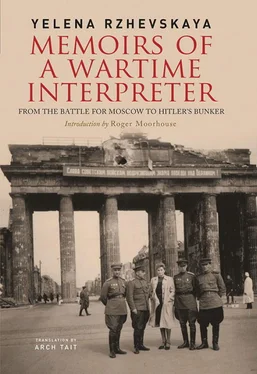Judging by the documents, soon after the general left Finow, there was an influx to ‘the heights’ of top secret information ‘concerning the discovery of Hitler’s body’. The Council of Ministers Archive preserves a ‘Note via the top-security line’, sent by Lieutenant General Vadis to Beria and Abakumov on 23 May 1945, [1] http://feldgrau.info/other/6484-statya-r-belforda-gitler-trup-ili-legenda . Accessed 23 December 2017.
detailing the circumstances of the discovery of the bodies of Hitler and Eva Braun; the testimony of Kunz and Schneider, the former having heard about Hitler’s suicide from Goebbels, while the latter reported the request for petrol; the interrogations of Günsche and Linge confirming the fact of the suicide and burning of the bodies; and the identification of Hitler’s teeth by Fritz Echtmann and Käthe Heusermann. And the note from Beria to Comrade Stalin and to Comrade Molotov, passing on the information. Everyone was very busy, but what would Stalin do? Would he announce the discovery?
Next, Colonel Gorbushin was summoned to Moscow to report on Hitler to Stalin. Gorbushin had just returned from Flensburg. When he returned from Moscow, he told Bystrov and myself he had been ordered not to leave his hotel room and to await a call from Stalin, which never came. Instead, he was summoned by Abakumov, who said,
Comrade Stalin has familiarized himself with the entire course of events and the documents relating to the discovery of Hitler, and he has no questions. He considers the matter closed. At the same time, Comrade Stalin said, ‘But we shall not make this public. The capitalist encirclement continues.’
Vasiliy Gorbushin told me and Bystrov now to forget what he had said.
‘Hitler – Corpse or Legend?’ Such was the title of an article by Ronald Belford, circulated on 25 May 1945 by Reuters, [1] R. Belford’s article: ‘Hitler – a Corpse or a Legend?’, in V. K. Vinogradov, J. F. Pogonyi and N. V. Teptzov, Hitler’s Death, London: Chaucer Press, 2005, p. 277.
and that was precisely the question we confronted. ‘The examination of these human remains’, Reuters’ reporter wrote, ‘is the culmination of a strenuous week-long search in the ruins of Berlin.’ It was a culmination, however, that never happened. What happened instead was a cover-up.
A tyrant is always a mystery and that is his strength. Everything emanating from him is imbued with a secret significance hidden from the eyes of his subjects. Stalin’s pragmatic motivations are easier to work out, but not sufficient to explain why he would conceal such an important historical fact. The answer is largely hidden away in his inscrutable personality, in his ambiguous attitude towards Hitler, in the way he measured himself against certain analogous situations in which Hitler found himself, in the devastating sense of loss he may have experienced with the death of the hated, alluring enemy he had spent the days and nights of the war opposing, and in Stalin’s many psychological complexes. These depths I will not attempt to plumb.
The foreign enemy and, no less, the domestic enemy, were an essential component of the system Stalin created. He loathed the idea of detente, and there would be less pressure for it if Hitler was still alive and secretly hiding somewhere. If Hitler was alive, Nazism was not yet vanquished and the world was still in danger. Stalin saw that as tactically important in the imminent discussions with the Allies about the nature of the postwar world. So in Potsdam, when he was asked whether anything was known about Hitler, he was evasive. With a knack for dealing unceremoniously with inconvenient facts that by rights belonged to history and hence to the people, Stalin sat on the truth.
History abhors the arbitrary removal from its narrative of this or that particular event, no matter what the motivation. It is a great theatre producer, and trying to correct its productions only spoils them.
Was Stalin wise? Was there some advantage he derived from keeping his secret? Hardly. The political and moral damage, however, was immense. At the end of the war, and for some time after it, the approval rating (as people would say nowadays) of the Red Army throughout the world was extremely high. If, when Stalin was asked about Hitler at the Potsdam Conference, he had announced he was ready to provide proof that Hitler had been found, imagine the impact! A total triumph for Stalin! For the Red Army! And his work at the conference would have benefited from that far more than it did from galvanizing a corpse. But I wonder now, as I write, whether Stalin was already sensing a growing tension between himself and his Allies, and concealing a truth that was their common achievement was perhaps his first move in the approaching Cold War. So he threw that question at ‘played-out’ Zhukov: ‘Well, where is Hitler?’
When I was demobilized and, five months later, left Germany for good, as it then seemed, the Allies continued to work, trying to reach a definite conclusion. In late October and early November (by which time I was already back in Moscow), they were trying to bring together all the loose ends and appealed to the Soviet side for assistance. On 31 October, as a goodwill gesture, the record of the interrogation of Hanna Reitsch was sent by US intelligence to Major General Sidnev, [1] Alexey Sidnev, deputy head of the Smersh directorate of the 1st Byelorussian Front. Birstein, p. 304.
Following that, on 1 November, Brigadier General Ford sent a circular to Brigadier General Conrad (USA), Major General Sidnev (USSR) and Colonel Poulu (France), proposing that the next meeting of the Intelligence Committee should discuss the various claims about Hitler’s death.
First paragraph of that text: ‘The only conclusive proof of Hitler’s death would be the finding and definite identification of the body.’
It was, however, just this conclusive proof that was being denied, concealed both from the Allies and from Russians themselves. Brigadier General Ford continues, ‘In the absence of this proof, the only positive proof consists of the detailed accounts of particular witnesses who were either acquainted with his intentions or were eyewitnesses to his fate.’
As we have seen, there really was no shortage of such witnesses. Analysing the testimony of those witnesses who fell into the hands of the Allies, and the information that had leaked from our side, the British intelligence officer summarizes:
It is impossible to suppose that the accounts of the various eyewitnesses are a fabricated story. They were all too busy planning their own escapes to… have any inclination to memorize a fictional charade that they would maintain for five months in isolation from each other under detailed and persistent cross-examination.
However, the evidence about the last days and death of Hitler is ‘not yet complete’, and Brigadier General Ford appeals to his colleagues on the quadripartite Intelligence Committee for information about the where-abouts of, and a request to be allowed to interrogate, Günsche and Rattenhuber (who are in captivity ‘according to the Russian communique of 7 May’), Traudl Junge (Gertraud but called Gertruda in our records) and Hans Baur, Hitler’s personal pilot, who had been seriously injured and, according to unconfirmed reports, was in hospital, again in the Russian sector.
At the end of this message to his colleagues is the most important point:
A rumour came from the Russian side that a body had been found that was identified, or was believed to have been identified, as Hitler’s body from the teeth. Could they perhaps report the results of that investigation to establish the extent to which that can be relied on?
There was no response.
Evidently it had not proved possible to conceal the facts completely, and perhaps nobody had tried all that hard. The main thing was to keep everybody guessing. ‘Nothing for sure.’ ‘Hitler vanished without trace’. That provided a foundation for legends and myths about him: just what Hitler wanted. A romantic aura was created around his image, while the truth that we knew was simple and prosaic. But it was the truth.
Читать дальше











